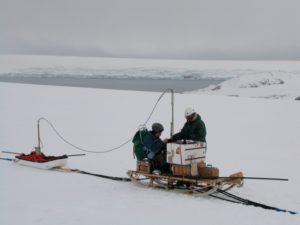 The use of the radio-echo sounder of ground-penetrating radar over the glacier surface or from helicopter or airplane allows us to determine geometric and structural properties of a glacier.
The use of the radio-echo sounder of ground-penetrating radar over the glacier surface or from helicopter or airplane allows us to determine geometric and structural properties of a glacier.
For instance, it allows to determine the ice thickness, the internal layering and the possible presence of endoglacial water channels or crevassed buried by snow.
The method is based upon radar techniques: by measuring the time elapsed from the transmission of an electro-magnetic (e-m) wave and the reception of its echo, and assuming that we know the velocity of propagation of e-m waves through ice, we can estimate the distance to the body or structure (layer, crevasse, glacier bed) that generated the reflection of the transmitted wave.
Because the velocity of propagation of e-m waves depends on physical properties of the ice such as its dielectic permittivity or water content (liquid water contained within pores or microchannels between ice crystals), the analysis of radar records allows us to study these ice properties. The strength of the reflection from the glacier bed depends on the amount of water in the ice-bed interface, and also depends on the bed roughness. Consequently, the ground-penetrating radar is also an ideal tool for determining the structure and properties of the glacier bed, which is not accessible for direct observation.